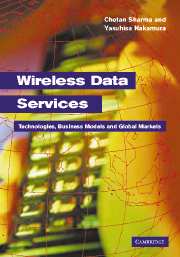Book contents
- Frontmatter
- Contents
- List of figures
- About the authors
- Foreword
- Acknowledgements
- List of abbreviations
- 1 Introduction
- 2 The impact of globalization
- 3 Adoption trends and analysis by region
- 4 Subscriber needs and expectations
- 5 The wireless value chain
- 6 Global wireless technologies: systems and architectures
- 7 Global wireless technologies: network, access, and software
- 8 Business models and strategies
- 9 Business issues and challenges
- 10 Technology issues and challenges
- 11 Case studies
- 12 Perspectives
- 13 Future of wireless technologies, applications and services
- 14 Conclusions and recommendations
- References and recommended reading
- Index
6 - Global wireless technologies: systems and architectures
Published online by Cambridge University Press: 06 August 2009
- Frontmatter
- Contents
- List of figures
- About the authors
- Foreword
- Acknowledgements
- List of abbreviations
- 1 Introduction
- 2 The impact of globalization
- 3 Adoption trends and analysis by region
- 4 Subscriber needs and expectations
- 5 The wireless value chain
- 6 Global wireless technologies: systems and architectures
- 7 Global wireless technologies: network, access, and software
- 8 Business models and strategies
- 9 Business issues and challenges
- 10 Technology issues and challenges
- 11 Case studies
- 12 Perspectives
- 13 Future of wireless technologies, applications and services
- 14 Conclusions and recommendations
- References and recommended reading
- Index
Summary
We have come a long way from the early 1980s when the first-generation analog cellular networks were deployed; cellular phones used to weigh more than a pound, looked ugly, and were considered the toys of only the elite. Fast forward to the present. There are already several successful deployments of third-generation (3G) digital wireless networks, the sleek cellular phones weigh less than a few ounces and are considered indispensable tools for common man worldwide. In this chapter, we will look at the technologies impacting the wireless world and lay out a framework of technologies that will become the basis of our discussions in future chapters. We will cover not only some of the core wireless technologies but also the computing and communications technologies that impact on the wireless world. Detailed discussion of these technologies is beyond the scope of the book; however, we provide a list of references for anyone interested in further research.
The pervasive computing landscape
One of the most fundamental transition that is in progress in the information world is the evolution of pervasive computing (also known as ubiquitous computing). Pervasive computing in a nutshell means access to any information, anytime, anywhere using any device and any network. It means empowering the end-user with unprecedented access to information and the ability to act on it. This transition has been fostered by the ever-growing convergence of the computing and communications industries with consumer electronics and content and services.
- Type
- Chapter
- Information
- Wireless Data ServicesTechnologies, Business Models and Global Markets, pp. 95 - 123Publisher: Cambridge University PressPrint publication year: 2003

